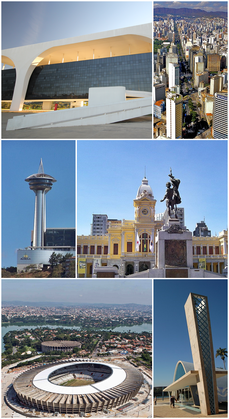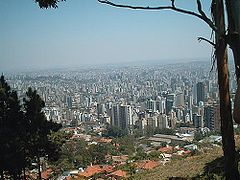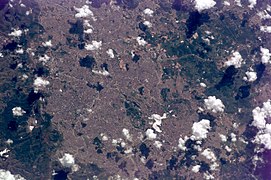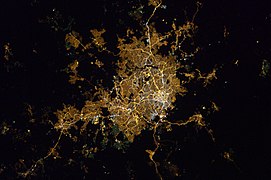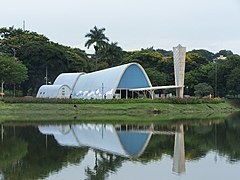Belo Horizonte
| Município de Belo Horizonte "BH", "Belô",
Belo Horizonte
"Cidade de Minas", "Cidade-jardim" |
|||
|---|---|---|---|
|
From above: Church of St. Francis of Assisi , Praça Rui Barbosa; Panoramic view; Pampulha with the Mineirão Stadium; Seat of government; View of the center.
|
|||
|
|
|||
| Coordinates | 19 ° 55 ′ S , 43 ° 56 ′ W | ||
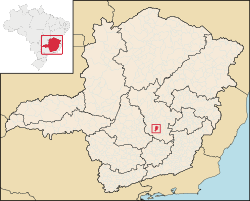
|
|||
| Symbols | |||
|
|||
| founding | December 12, 1897 | ||
| Basic data | |||
| Country | Brazil | ||
| State | Minas Gerais | ||
| ISO 3166-2 | BR-MG | ||
| Região intermediária | Belo Horizonte (since 2017) | ||
| Região imediata | Belo Horizonte (since 2017) | ||
| Mesoregion | Belo Horizonte (1989-2017) | ||
| Microregion | Belo Horizonte (1989-2017) | ||
| Metropolitan area | Belo Horizonte metropolitan area | ||
| structure | 9 administrative regions | ||
| height | 852 m | ||
| climate | tropical, Aw | ||
| surface | 331.4 km² | ||
| Residents | 2,375,151 (2010) | ||
| density | 7167 Ew. / km² | ||
| estimate | 2,512,070 (July 1, 2019) | ||
| Parish code | IBGE : 3106200 | ||
| Post Code | 30000-000 to 31999-999 | ||
| Telephone code | (+) 31 | ||
| Time zone | UTC −3 | ||
| Website | www.pbh.gov.br (Brazilian Portuguese) | ||
| politics | |||
| City Prefect | Alexandre Kalil (2017-2020) | ||
| Political party | Partido Humanista da Solidariedade (PHS) | ||
| economy | |||
| GDP | 88,277,463 thousand R $ 35,122 R $ per person (2016) |
||
| HDI | 0.810 (2010) | ||
Belo Horizonte [ ˌbɛlu.oɾiˈzõtʃi ] (German Beautiful Horizon , officially Portuguese Município de Belo Horizonte ) is one of the most important cities in Brazil .
It is the capital of the state of Minas Gerais and is located in the southeast of the country. With a population of just over two and a half million (2019), Belo Horizonte, or “BH” (pronounced “be-agah”), as it is often called, is an economic and cultural center.
history
The place was founded by a gold prospector from São Paulo named João Leite da Silva Ortiz. He had come to the region, found an acceptable climate and decided to set up a farm called Curral Del Rey (outdated Portuguese for "corral (fence, pen) of the king"). The prosperity of the farm attracted more people to the region.
When Brazil became a republic in 1889, Curral Del Rey was chosen as the new capital of Minas Gerais. It replaced Ouro Preto in this function. However, the city only received the name Belo Horizonte and the status of capital on December 12, 1897, which is the official date of birth of the city.
The streets of Belo Horizonte were planned by the city planner Aarão Reis in a checkerboard pattern with main avenues running diagonally. Since the streets were named after personalities and Indian groups from Brazilian history on the one hand and regions of Brazil on the other, one can still orientate oneself in the city center with appropriate knowledge of the geography and history of Brazil. However, the city's rapid growth, particularly in the last twenty years of the 20th century, far exceeded its planning and the city is now facing major infrastructure problems. About 20 percent of the population have no access to the sewer system.
The entrepreneur Alexandre Kalil has been mayor of Belo Horizonte since January 2017.
Demographics
| year | population |
|---|---|
| 1991 | 2,013,257 |
| 2000 | 2,238,526 |
| 2010 | 2,375,151 |
| 2019 | 2,512,070 |
Archdiocese of Belo Horizonte
economy
Most of Minas Gerais' industrial plants are located in the metropolitan area of Belo Horizonte (with the towns of Betim , Sete Lagoas and Contagem ) . These are mostly processing companies in the metal industry and the textile industry . The Italian automobile manufacturer Fiat operates a plant in Betim . The German Chamber of Commerce Abroad has a branch in Belo Horizonte.
According to a study from 2014, the greater Belo Horizonte area has a gross domestic product of 84.87 billion US dollars in purchasing power parity. In the ranking of the economically strongest metropolitan regions worldwide, the city took 156th place. The GDP per capita is $ 15,134 (PPP).
traffic
The main load of local public transport in Belo Horizonte is carried by buses, some of which have their own bus lanes on the major main traffic axes ( Bus Rapid Transit ). There is also an above-ground S-Bahn line (metrô terrestre) .
Belo Horizonte has two airports. Pampulha Airport (PLU / SBBH), which is around nine kilometers from the city center, serves domestic connections to numerous Brazilian cities. In 2002 around 89,000 aircraft movements were registered here and around three million passengers were handled. Tancredo Neves International Airport (CNF / SBCF) in Confins is the city's international airport. It is located approx. 40 km north of the city and is connected to the city center via the “linha verde” motorway (green line).
Attractions
The Pampulha district is home to a cluster of important buildings, notably the Igreja de São Francisco de Assis (St. Francis Church), designed by the famous Brazilian modern school architect Oscar Niemeyer . Pampulha is also home to the largest football stadium in Minas Gerais, the Mineirão .
The Mangabeiras Park and the City Park are also worth seeing . The first is in the southern part of the city and has a wide view of the metropolis.
gallery
Sports
The Clube Atlético Mineiro (“Galo” or “Atlético Mineiro” in German-speaking countries) and Cruzeiro EC (German-speaking: “Cruzeiro Belo Horizonte”) play in Serie A , the top division in Brazilian football. The women's and men's teams of the Minas Tenis Clube also play volleyball in the Brazilian Super League.
The city wrote sports history with the “ Mineiraço ” in the Estádio Governador Magalhães Pinto on July 8, 2014, the semi-final of the 2014 World Cup , in which the German national team competed against the Brazilian and won 7-1.
Climate table
| Belo Horizonte | ||||||||||||||||||||||||||||||||||||||||||||||||
|---|---|---|---|---|---|---|---|---|---|---|---|---|---|---|---|---|---|---|---|---|---|---|---|---|---|---|---|---|---|---|---|---|---|---|---|---|---|---|---|---|---|---|---|---|---|---|---|---|
| Climate diagram | ||||||||||||||||||||||||||||||||||||||||||||||||
| ||||||||||||||||||||||||||||||||||||||||||||||||
|
Monthly average temperatures and rainfall for Belo Horizonte
Source: wetterkontor.de
|
|||||||||||||||||||||||||||||||||||||||||||||||||||||||||||||||||||||||||||||||||||||||||||||||||||||||||||||||||||||||||||||||||||||||||||||||||||||||||||||||||||||
Town twinning
Sister cities of Belo Horizonte are
|
There are bilateral cooperation agreements with
-
 Windhoek , Namibia
Windhoek , Namibia -
 Milan , Italy
Milan , Italy -
 Mexico City , Mexico
Mexico City , Mexico -
 Dusseldorf , Germany
Dusseldorf , Germany
sons and daughters of the town
The former president of Brazil Dilma Rousseff is one of the most famous personalities from Belo Horizonte .
Web links
- City Prefecture website , Prefeitura Municipal (Brazilian Portuguese)
- City Council website , Câmara Municipal (Brazilian Portuguese)
- Statistical data on the website of the Instituto Brasileiro de Geografia e Estatística (IBGE)
- ARqBH - Architecture Belo Horizonte
- Belo Horizonte Photolog
- BeloHorizonte.com - Portal for Belo Horizonte, Minas Gerais, Brazil
Individual evidence
- ↑ a b c Belo Horizonte - Panorama. In: cidades.ibge.gov.br. IBGE , accessed August 22, 2019 (Brazilian Portuguese).
- ↑ Agência Brasil: Alexandre Kalil é eleito prefeito de Belo Horizonte , October 30, 2016, accessed on February 18, 2017.
- ^ Alan Berube, Jesus Leal Trujillo, Tao Ran, and Joseph Parilla: Global Metro Monitor . In: Brookings . January 22, 2015 ( brookings.edu [accessed July 30, 2018]).
- ↑ Belo Horizonte website: RELAÇÕES INTERNACIONAIS , accessed on November 19, 2016
